𝑪𝒓𝒂𝒛𝒚 𝑩𝒆𝒂𝒖𝒕𝒊𝒇𝒖𝒍 2001

Introducing Crazy/Beautiful (2001) – A Comprehensive Overview
An Emotionally Charged and Complex Teen Romance
Crazy/Beautiful (2001), directed by John Stockwell, is an American teen romantic drama that blends a passionate love story with profound explorations of class disparity, mental health, and family pressures. Starring Kirsten Dunst as Nicole Oakley and Jay Hernandez as Carlos Nuñez, the film follows the romance between a wealthy, rebellious girl and a hardworking Mexican-American student from the inner city. Released on June 29, 2001, by Touchstone Pictures, Crazy/Beautiful stands out for its authentic performances and attempts to transcend the clichés of the teen genre, though it doesn’t entirely escape familiar tropes. It has become a cult classic of the 2000s, cherished for its sincerity and evocative soundtrack. This article provides a comprehensive look at the film’s narrative, cast, production, themes, reception, and cultural significance, offering a complete introduction to its lasting legacy.

Synopsis: A Love Story Overcoming Social Barriers
Set at Palisades Charter High School in Los Angeles, Crazy/Beautiful centers on Carlos Nuñez (Jay Hernandez), a 17-year-old Mexican-American honor student who commutes two hours by bus daily from East LA to attend a prestigious school in Pacific Palisades, dreaming of becoming a naval aviator at the U.S. Naval Academy. During a day at Santa Monica Beach, Carlos meets Nicole Oakley (Kirsten Dunst), a rebellious classmate performing community service picking up trash as part of a DUI sentence. Nicole, the daughter of a wealthy congressman (Bruce Davison), leads a reckless life filled with parties, alcohol, and self-destructive behavior, stemming from her mother’s death when she was young and a strained relationship with her father.
Nicole’s initial flirtation with Carlos, sparked by impulse, quickly blossoms into a deep romance. Carlos, serious and responsible, is drawn to Nicole’s freedom and vulnerability, while she finds stability and sincerity in him. However, Nicole’s self-destructive tendencies—drinking, skipping school, and reckless acts—threaten Carlos’s ambitions, especially when she pulls him into dangerous situations, like a break-in that lands him in detention. Carlos’s family and friends, including his mother, Mrs. Nuñez (Soledad St. Hilaire), and best friend Hector (Rolando Molina), worry that Nicole will derail his dreams. Meanwhile, Nicole’s father, Tom, and stepmother, Courtney (Lucinda Jenney), disapprove of the relationship, blaming Carlos as a bad influence while ignoring their daughter’s deeper issues.
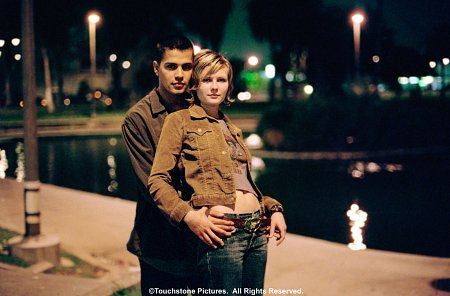
The narrative builds to a climax as Nicole confronts her inner demons, including a suicide attempt, and Carlos must decide whether to continue the relationship or focus on his future. An emotional confrontation with Nicole’s father, who ultimately acknowledges his shortcomings in supporting her, leads to a hopeful resolution where Carlos’s love helps Nicole begin her healing journey. Running at 99 minutes, Crazy/Beautiful is a heartfelt romance that doesn’t shy away from the complexities of teen love, delivering an ending that is both touching and realistic.
Kirsten Dunst and Jay Hernandez: A Chemistry-Fueled Duo
The performances of Kirsten Dunst and Jay Hernandez are the heart of Crazy/Beautiful, bringing authenticity and emotional depth to their romance. Kirsten Dunst, then 19, delivers a standout performance as Nicole Oakley, a complex character torn between pain and rebellion. Fresh off The Virgin Suicides (1999), Dunst chose this role to break from her “good girl” image, as she shared in a 2001 Entertainment Weekly interview. Her makeup-free look, with tousled hair and natural style, enhances the character’s raw authenticity, as praised by The New York Times. Dunst conveys Nicole’s vulnerability through explosive emotional scenes, like confronting her father, and charm in tender moments with Carlos, making Nicole both sympathetic and compelling.
Jay Hernandez, in his film debut, shines as Carlos Nuñez, bringing sincerity and determination to a character caught between love and duty. His performance, lauded by Roger Ebert for its “natural, unforced” quality, highlights Carlos’s conflict as he balances ambition with his feelings for Nicole. The chemistry between Dunst and Hernandez, described by Letterboxd as “the best you’ll ever see,” is the film’s lifeblood, with intimate scenes like a hotel moment or Carlos’s family party showcasing their deep connection.
The supporting cast enhances the story. Bruce Davison, as Tom Oakley, delivers a nuanced portrayal of a loving but disconnected father, while Lucinda Jenney, as Courtney, is criticized for being a “stereotypical wicked stepmother,” per Common Sense Media. Soledad St. Hilaire, as Mrs. Nuñez, adds warmth and realism, while Rolando Molina and Taryn Manning, as Nicole’s friend Maddy, bring humor and loyalty. The ensemble, though with some flat characters, creates a vivid tapestry of relationships and societal tensions, with Dunst and Hernandez as the radiant center.
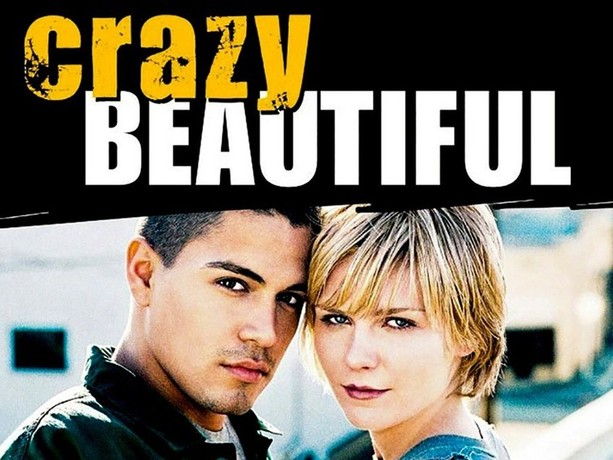
Production: A Teen Film with Guts
Directed by John Stockwell, previously behind Cheaters (2000), Crazy/Beautiful was written by Phil Hay and Matt Manfredi, drawing inspiration from class-crossing love stories like West Side Story but modernized with a 2001 LA setting. Produced by Touchstone Pictures with a $13 million budget, the film was shot in Los Angeles, including Pacific Palisades, Malibu, Santa Monica, and East LA, capturing the contrast between affluent and working-class neighborhoods, as noted on Wikipedia. Cinematographer Shane Hurlbut used natural lighting and intimate angles to highlight the settings’ beauty and the characters’ closeness, as praised by AllMovie.
The soundtrack, composed by Paul Haslinger, incorporates standout tracks like David Gray’s “This Year’s Love,” Seven Mary Three’s “Wait,” and La Ley’s “Siempre (Everytime),” released by Hollywood Records on June 26, 2001, per Wikipedia. These songs, especially “This Year’s Love,” became emblematic of early 2000s teen romance, as fans on Reddit note. Production design by Maia Javan and Maria Nay authentically recreates LA’s fashion and culture, from Nicole’s beachy outfits to Carlos’s crowded home.
Production faced significant challenges due to Touchstone’s mandate for a PG-13 rating instead of the intended R, per Wikipedia. Disney required Stockwell to cut 35 profanities, a sex scene, and depictions of Nicole’s drinking and drug use, diluting the realism of her mental health struggles, as Common Sense Media points out. A planned nude scene was scrapped due to Dunst’s mother’s refusal, as she was only 17, per Wikipedia. Originally titled At Seventeen, the film was renamed Crazy/Beautiful to reflect the lead couple’s dynamic, as documented on Fandango.
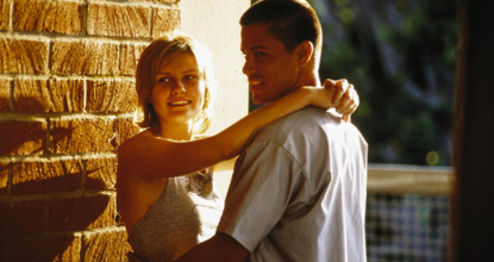
Themes and Symbolism: Love, Class Divide, and Mental Health
Crazy/Beautiful explores themes of teen romance, class disparity, mental health, and redemption, offering a fresh take on cross-cultural love stories. Nicole and Carlos’s relationship, likened to Romeo and Juliet by AllMovie, highlights the clash between elite privilege and working-class struggle. Nicole’s self-destructive behavior, rooted in her mother’s death and her father’s neglect, reflects mental health issues like depression and suicidal tendencies, though the film is criticized for using these as dramatic devices rather than exploring them deeply, per Common Sense Media.
Cultural differences shine in scenes like Carlos’s family party, where Nicole feels out of place as the only white girl, underscoring cultural tensions, as noted by TV Tropes. Their love, though initially physical, evolves into a deeper bond that helps Nicole confront her trauma, as praised by Rotten Tomatoes for avoiding genre clichés. Symbolically, Nicole’s lavish Malibu home versus Carlos’s cramped East LA apartment reflects class divides, while Santa Monica Beach, where they meet, serves as a neutral space for their love to bloom.
The film also touches on race, with bigoted remarks from Nicole’s friends and her father’s suspicions about Carlos highlighting interracial tensions, as Common Sense Media notes. Yet, its message of tolerance and love transcending barriers is delivered without preachiness, as Amazon comments observe.
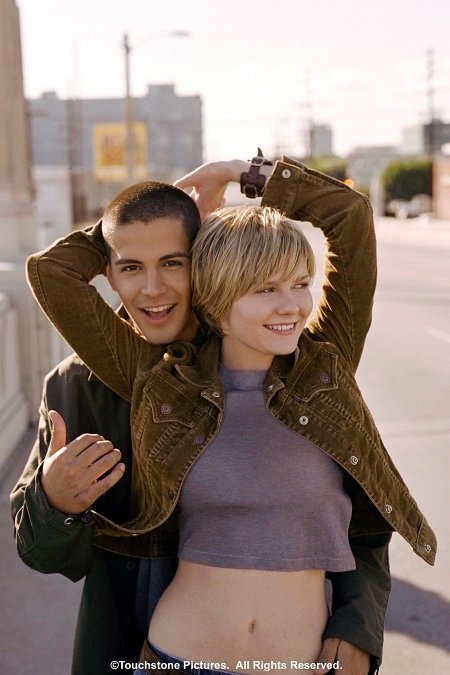
Reception and Impact: A Teen Classic with Mixed Reviews
Crazy/Beautiful received mixed reviews, earning a 63% approval rating on Rotten Tomatoes from 99 critics and a 61/100 on Metacritic from 26, indicating “generally favorable” feedback. Roger Ebert gave it three stars, calling it “an unusually observant teenage romance” for Dunst and Hernandez’s authenticity, though noting it was toned down for PG-13. The New York Times’ A.O. Scott praised the acting and vibrant soundtrack but criticized supporting characters as “flat and superficial,” deeming it “a vast improvement over soulless teen romances.” Common Sense Media gave three stars, noting nothing new in this “teen fantasy” but appreciating Dunst and Hernandez for “warm, thoughtful” performances.
Audiences responded more positively, especially teens, with a 69% Popcornmeter on Rotten Tomatoes from over 50,000 ratings. Letterboxd fans lauded the leads’ chemistry and soundtrack, with comments like “Dunst makes me love this film” from 2001 viewers. 2025 Reddit posts from u/vinoKwine on r/2000sNostalgia reflect nostalgia, with fans calling it “a timeless love story” thanks to David Gray’s song. However, some criticized its formulaic plot and superficial handling of Nicole’s mental health, as Reelviews noted, calling it “been there, done that.”
Commercially, the film opened at #9 at the U.S. box office, grossing $4.7 million its first week and $19.9 million globally, a modest return on its $13 million budget, per Wikipedia. Home video success, with a DVD release on November 13, 2001, by Buena Vista Home Entertainment, and streaming on platforms like Hulu extended its lifespan, as TV Guide notes.
Controversy focused on the PG-13 rating, which diluted Nicole’s mental health and substance issues, per Common Sense Media, and some viewers found supporting characters, especially Nicole’s stepmother, stereotypical. Still, the film earned 2002 ALMA Award nominations for Outstanding Motion Picture, Actor (Hernandez), and Song in a Soundtrack, reflecting recognition for Latino representation, per TV Guide.

Cultural Significance: A 2000s Teen Love Story
Crazy/Beautiful hit theaters during the peak of 2000s teen rom-coms, alongside Save the Last Dance (2001) and A Walk to Remember (2002), tapping into a fascination with cross-cultural love stories. Released in summer 2001, when blockbusters like The Fast and the Furious dominated, Crazy/Beautiful was a counterpoint, targeting teen audiences seeking emotional depth, as Reelviews notes. Its LA setting, contrasting affluent Pacific Palisades with working-class East LA, captured the city’s class and cultural divides, adding authenticity, per AllMovie.
Kirsten Dunst’s performance solidified her as a leading young actress, transitioning from “good girl” roles to complex characters, as The New York Times observes. Jay Hernandez’s debut paved the way for his career in Hostel (2005) and Bad Moms (2016), offering rare Latino representation in a romantic lead, as Amazon fans praise. The soundtrack, particularly David Gray’s “This Year’s Love,” became synonymous with 2000s nostalgia, as Reddit and Letterboxd note, with fans tying it to first loves.
Compared to Carmilla (2019), previously discussed, which explores queer love in a gothic setting, Crazy/Beautiful offers a modern heterosexual romance focused on class and mental health, but both depict young women (Nicole, Lara) grappling with societal oppression and personal identity. Crazy/Beautiful’s influence is seen in later teen dramas like The Fault in Our Stars (2014), balancing romance with serious issues, and its continued popularity on streaming platforms like Hulu and Peacock, per TV Guide, reflects its enduring appeal.
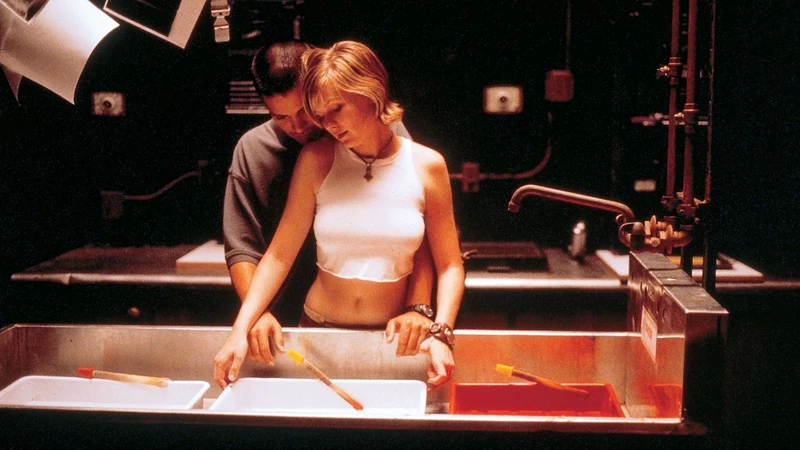
Legacy and Availability
Crazy/Beautiful remains a beloved 2000s classic, celebrated for Dunst and Hernandez’s performances, iconic soundtrack, and attempt to transcend teen film clichés, though limited by studio edits and formulaic elements. Its 2001 DVD release, including behind-the-scenes footage and Seven Mary Three’s “Wait” music video featuring Dunst and Hernandez, is a fan favorite, per Wikipedia. Academic analyses in Journal of Popular Film and Television explore its depiction of class and race, while Letterboxd and Reddit reviews praise its nostalgia and lead chemistry.
As of May 22, 2025, Crazy/Beautiful is available for streaming on Hulu, Peacock, Tubi, and Prime Video (subject to regional availability). Rental and purchase options exist on Amazon Video, Apple TV, Fandango at Home, YouTube, and Google Play. Physical DVD and Blu-ray copies are available through retailers like Amazon and Walmart, per Blu-ray.com.

Conclusion: A Timeless Teen Love Story
Crazy/Beautiful (2001) is an emotionally rich teen romantic drama that captures the intoxicating and complex nature of first love through Kirsten Dunst and Jay Hernandez’s authentic performances. John Stockwell’s direction, paired with a memorable soundtrack and vivid LA setting, delivers a story that’s both familiar and fresh, tackling class disparity, mental health, and redemption. Though constrained by its PG-13 rating and some stereotypical characters, its sincerity and lead chemistry make it a cherished cult classic, resonating with audiences over two decades later for its nostalgic charm and message of tolerance.
For fans of teen romances, cross-cultural stories, or 2000s nostalgia, Crazy/Beautiful offers a wild, heartfelt, and beautiful journey—one that still tugs at the heartstrings more than two decades on.